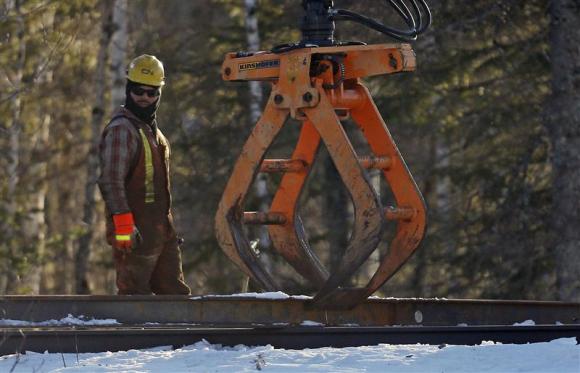Thousands of railcars need updating after crude crashes: Greenbriar CEO
Date: 09-Jan-14
Country: USA
Author: Kristen Hays

A CN worker looks on while working on the railway in Plaster Rock,
New Brunswick, January 8, 2014.
Photo: Mathieu Belanger
Some 80,000 tank cars that don't meet current industry safety standards need to be replaced or retrofitted after several crashes of trains carrying crude oil, the head of railcar maker The Greenbriar Companies said on Wednesday.
Chief Executive William Furman also said "modest but meaningful" improvements that can be implemented immediately could reduce major risks of a hazardous materials leak by as much as 80 percent in derailments.
"We believe a retrofit proposal if adopted can be completed in a reasonably expedited time frame and do not accept that there is not adequate capacity in the industry to do so," Furman said during Greenbriar's quarterly earnings conference call with analysts.
"The concern for public safety here is delay. Delay through the inability to act on the regulatory front while the public would like to see something done sooner."
The U.S. Department of Transportation's Pipeline and Hazardous Materials Safety Administration (PHMSA) is weighing new rules based on petitions from the railroad industry, shippers and recommendations from the National Transportation Safety Board.
Furman's comments came after a Canadian National Railway train carrying crude and propane derailed and caught fire late Tuesday in New Brunswick, Canada.
Last week a 106-car BNSF Railway Co crude oil train crashed into a derailed car carrying grain in North Dakota, causing multiple explosions and fires.
No one was hurt in either incident but both are the latest of multiple crude-carrying train accidents in North America that highlight safety issues as the oil-by-rail movement grows in tandem with the U.S. inland oil production boom.
The worst accident by far happened last July in a small Quebec town when a runaway train derailed and exploded, killing 47 people.
The Railway Supply Institute, which represents tank car owners, last month urged the PHMSA to adopt safety standards already embraced in October 2011 by the Association of American Railroads, the rail industry's trade group.
Under those standards tank railcars known as DOT-111s built after October 2011 should have thicker hulls and reinforced valves to better protect against punctures or leaks in derailments.
But those built before that date lack those features and the rail industry has said it could cost $1 billion to retrofit older railcars. Furman said on Wednesday that about 80,000 railcars "that are in question" were being used.
"Crude by rail is here to stay, provided that the public remains confident in the safety of rail transportation," he said.
The railcars involved in last week's North Dakota crash were pre-October 2011 designs, according to the National Transportation Safety Board's preliminary information.
A mass overhaul of those older cars or a move to replace them with new cars with the post-October 2011 design would be a boon to railcar manufacturers like Greenbriar.
Furman said the company was "well positioned to respond" to shippers' retrofitting or newbuild needs.
The U.S. East and West coasts are the major destinations for railed Bakken crude from North Dakota, as it is cheaper than imports and pipeline infrastructure is lacking.
The U.S. Gulf Coast also moves crude via rail, both from North Dakota and other oil plays, like the booming Eagle Ford shale and Permian Basin in Texas. But increased or converted pipeline infrastructure in Texas and Louisiana makes rail less critical than in the other regions.
(Reporting by Kristen Hays; Editing by Terry Wade and James Dalgleish)
![]()
© Thomson Reuters 2014 All rights reserved